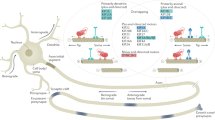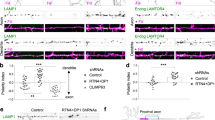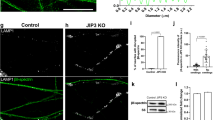Abstract
Proteolytic processing of amyloid precursor protein (APP) generates amyloid-β peptide and has been implicated in the pathogenesis of Alzheimer's disease1. However, the normal function of APP, whether this function is related to the proteolytic processing of APP, and where this processing takes place in neurons in vivo remain unknown. We have previously shown that the axonal transport of APP in neurons is mediated by the direct binding of APP to the kinesin light chain subunit of kinesin-I, a microtubule motor protein2. Here we identify an axonal membrane compartment that contains APP, β-secretase and presenilin-1. The fast anterograde axonal transport of this compartment is mediated by APP and kinesin-I. Proteolytic processing of APP can occur in the compartment in vitro and in vivo in axons. This proteolysis generates amyloid-β and a carboxy-terminal fragment of APP, and liberates kinesin-I from the membrane. These results suggest that APP functions as a kinesin-I membrane receptor, mediating the axonal transport of β-secretase and presenilin-1, and that processing of APP to amyloid-β by secretases can occur in an axonal membrane compartment transported by kinesin-I.
This is a preview of subscription content, access via your institution
Access options
Subscribe to this journal
Receive 51 print issues and online access
$199.00 per year
only $3.90 per issue
Buy this article
- Purchase on Springer Link
- Instant access to full article PDF
Prices may be subject to local taxes which are calculated during checkout



Similar content being viewed by others
References
Selkoe, D. J. Translating cell biology into therapeutic advances in Alzheimer's disease. Nature 399, A23–A31 (1999).
Kamal, A., Stokin, G. B., Yang, Z., Xia, C. & Goldstein, L. S. Axonal transport of amyloid precursor protein is mediated by direct binding to the kinesin light chain subunit of kinesin-I. Neuron 28, 449–459 (2000).
Vassar et al. β-secretase cleavage of Alzheimer's amyloid precursor protein by the transmembrane aspartic protease BACE. Science 286, 735–741 (1999).
De Strooper, B. et al. Deficiency of presenilin-1 inhibits the normal cleavage of amyloid precursor protein. Nature 391, 387–390 (1998).
Selkoe, D. J. & Wolfe, M. S. In search of γ-secretase: presenilin at the cutting edge. Proc. Natl Acad. Sci. USA 97, 5690–5692 (2000).
De Strooper, B. et al. A presenilin-1-dependent γ-secretase-like protease mediates release of Notch intracellular domain. Nature 398, 518–522 (1999).
Ray, W. J. et al. Cell surface presenilin-1 participates in the γ-secretase-like proteolysis of Notch. J. Biol. Chem. 274, 36801–36807 (1999).
Annaert, W. G. et al. Presenilin 1 controls γ -secretase processing of amyloid precursor protein in pre-Golgi compartments of hippocampal neurons. J. Cell Biol. 147, 277–294 (1999).
Walter, J. et al. The Alzheimer's disease-associated presenilins are differentially phosphorylated proteins located predominantly within the endoplasmic reticulum. Mol. Med. 2, 673–691 (1996).
Koo, E. H. & Squazzo, S. L. Evidence that production and release of amyloid β-protein involves the endocytic pathway. J. Biol. Chem. 269, 17386–17389 (1994).
Thinakaran, G., Teplow, D. B., Siman, R., Greenberg, B. & Sisodia, S. S. Metabolism of the “Swedish” amyloid precursor protein variant in neuro2a (N2a) cells. Evidence that cleavage at the “β-secretase” site occurs in the Golgi apparatus. J. Biol. Chem. 271, 9390–9397 (1996).
Xu, H. et al. Generation of Alzheimer β-amyloid protein in the trans-Golgi network in the apparent absence of vesicle formation. Proc. Natl Acad. Sci. USA 94, 3748–3752 (1997).
Chyung, A. S. C., Greenberg, B. D., Cook, D. G., Doms, R. W. & Lee, V. M. Novel β-secretase cleavage of β-amyloid precursor protein in the endoplasmic reticulum/intermediate compartment of NT2N cells. J. Cell Biol. 138, 671–680 (1997).
Skovronsky, D. M., Doms, R. W. & Lee, V. M. Detection of a novel intraneuronal pool of insoluble amyloid β protein that accumulates with time in culture. J. Cell Biol. 141, 1031–1039 (1998).
Maltese, W. A. et al. Retention of the Alzheimer's amyloid precursor fragment C99 in the endoplasmic reticulum prevents formation of amyloid β-peptide. J. Biol. Chem. 276, 20267–20279 (2001).
Cupers, P. et al. The discrepancy between presenilin subcellular localization and γ-secretase processing of amyloid precursor protein. J. Cell Biol. 154, 731–740 (2001).
Zheng, H. et al. β-amyloid precursor protein-deficient mice show reactive gliosis and decreased locomotor activity. Cell 81, 525–531 (1995).
Dawson, G. R. et al. Age-related cognitive deficits, impaired long-term potentiation and reduction in synaptic marker density in mice lacking the β-amyloid precursor protein. Neuroscience 90, 1–13 (1999).
Seabrook, G. R. et al. Mechanisms contributing to the deficits in hippocampal synaptic plasticity in mice lacking amyloid precursor protein. Neuropharmacology 38, 349–359 (1999).
Magara, F. et al. Genetic background changes the pattern of forebrain commissure defects in transgenic mice underexpressing the β-amyloid-precursor protein. Proc. Natl Acad. Sci. USA 96, 4656–4661 (1999).
Ferreira, A., Niclas, J., Vale, R. D., Banker, G. & Kosik, K. S. Suppression of kinesin expression in cultured hippocampal neurons using antisense oligonucleotides. J. Cell Biol. 117, 595–606 (1992).
Okada, Y., Yamazaki, H., Sekine-Aizawa, Y. & Hirokawa, N. The neuron-specific kinesin superfamily protein KIF1A is a unique monomeric motor for anterograde axonal transport of synaptic vesicle precursors. Cell 81, 769–780 (1995).
Otsuka, A. J. et al. The C. elegans unc-104 gene encodes a putative kinesin heavy chain-like protein. Neuron 6, 113–122 (1991).
Potempska, A., Styles, J., Mehta, P., Kim, K. S. & Miller, D. L. Purification and tissue level of the β-amyloid peptide precursor of rat brain. J. Biol. Chem. 266, 8464–8469 (1991).
Hollenbeck, P. J. The distribution, abundance and subcellular localization of kinesin. J. Cell Biol. 108, 2335–2342 (1989).
Xia, W. et al. Presenilin complexes with the C-terminal fragments of amyloid precursor protein at the sites of amyloid β-protein generation. Proc. Natl Acad. Sci. USA 97, 9299–9304 (2000).
Bowman, A. B. et al. Kinesin-dependent axonal transport is mediated by the Sunday driver (SYD) protein. Cell 103, 583–594 (2000).
Verhey, K. J. et al. Cargo of kinesin identified as JIP scaffolding proteins and associated signaling molecules. J. Cell Biol. 152, 959–970 (2001).
Kim, S. H., Lah, J. J., Thinakaran, G., Levey, A. & Sisodia, S. S. Subcellular localization of presenilins: association with a unique membrane pool in cultured cells. Neurobiol Dis. 7, 99–117 (2000).
Cao, X. & Sudhof, T. C. A transcriptively active complex of APP with Fe65 and histone acetyltransferase Tip60. Science 293, 115–120 (2001).
Acknowledgements
We thank G. Stokin for the Kif5b antibody, S. Brady for the 63-90 Klc antibody, S. Sisodia for providing the Ps1, Aplp1 and Aplp2 antibodies, and Merck for the APP-null mice. We thank D. Cleveland for discussions, and S. Emr for use of the deconvolution microscope. This work is supported by a grant from the National Institutes for Health. L.S.B.G. is an investigator of the Howard Hughes Medical Institute.
Author information
Authors and Affiliations
Corresponding author
Supplementary information

Figure 1
(JPG 24.06 KB)
a, APP, BACE and PS1 accumulate proximal to a sciatic ligation. The sciatic nerves of wild-type mice were ligated unilaterally at the midpoint for 6hrs, sections were processed for immunohistochemistry as described in methods, and stained with antibodies to APP, BACE and PS1. Bar is 100 microns. b, APP, BACE, and PS1 co-localize proximal to a sciatic ligation. Wild-type mouse sciatic nerves were ligated unilaterally at the midpoint for 6hrs, sections were processed for immunohistochemistry as described in methods, co-stained with antibodies to BACE and APP or BACE and PS1. Arrows show co-localization whereas arrowheads point to nerve fibers where this is little co-localization. Bar is 2 microns.

Figure 2
(JPG 36.35 KB)
Immunofluoresence localization of kinesin-I, APP, BACE, and PS1 in mouse sciatic nerves. Cross-sections of mouse sciatic nerves were double-stained with antibodies to KLC1 and axonal marker SMI-31, KLC1 and Schwann marker S100, APP and S100, BACE and S100, or PS1 and S100, and then detected with FITC (green) or Texas-red (red) secondary antibodies; merged images in each panel are shown on the right. Arrows indicate axons, and arrowheads indicate Schwann cells. Comparable staining (not shown) of APP null mice with the APP antibody revealed a much reduced intensity of staining, which is presumably due to cross-reactivity with APLP1 and APLP2. Bar is 10 micron.

Figure 3
(JPG 22.82 KB)
APP, BACE, PS1 and kinesin-I are present in a specific subset of vesicles in mouse sciatic nerves. a, Fractionation profile of vesicles. Mouse sciatic nerves were fractionated as described in methods. 50ug each of the various fractions were analyzed by SDS-PAGE and Western blots with the indicated antibodies. b, Immunoisolation of vesicles from P3. Vesicles were immunoisolated with either no antibody (No Ab) or antibodies to KLC (63-90), KIF5B, APP (C-terminal pAb), or synaptotagmin (SYT). Equal amounts of bound (vesicle IP) and unbound vesicles were analyzed by SDS-PAGE and Western blots with the indicated antibodies. c, Immunoisolation of vesicle proteins in the presence of detergent. Vesicles were prepared and immunoisolated in the presence of 1% NP-40 detergent. The unbound supernatant (supe) and detergent vesicle IP’s were analyzed by SDS-PAGE and Western blots using the indicated antibodies.

Figure 4
(JPG 30.32 KB)
Ab is present mouse sciatic nerves. a, Ab40 and Ab42 immunoreactivity is present in mouse sciatic nerve extracts. Mouse sciatic nerve extracts were prepared from wild-type (wt) and mutant (-/-) APP mice, and analyzed on Tris-tricine gels and Western blots using the three Ab antibodies, Ab40 or Ab42 or 4G8. b, Ab40 and Ab42 antibodies recognize synthetic peptides and can co-immunoprecipitate Ab40 and Ab42 from sciatic nerve extracts. Wild-type mouse sciatic nerves were immunoprecipitated with the antibodies Ab40 or Ab42 or 4G8, and the immunoprecipitates (IP) and supernatant (supe) remaining were analyzed by Tris-tricine gels and Western blots using the indicated antibodies; Ab40 and Ab42 synthetic peptides (Calbiochem) were loaded as controls. c, Detection of Ab fragments in mouse sciatic nerves by SELDI mass spectroscopy. Spectra from SELDI analyses of immunoprecipitates of Ab from sciatic nerves of wild-type (wt) or APP null mutant mice using either Ab40 or Ab42 or 4G8 antibodies (see Table I for sequence assignments).
Rights and permissions
About this article
Cite this article
Kamal, A., Almenar-Queralt, A., LeBlanc, J. et al. Kinesin-mediated axonal transport of a membrane compartment containing β-secretase and presenilin-1 requires APP. Nature 414, 643–648 (2001). https://doi.org/10.1038/414643a
Received:
Accepted:
Published:
Issue Date:
DOI: https://doi.org/10.1038/414643a
This article is cited by
-
Abnormal accumulation of extracellular vesicles in hippocampal dystrophic axons and regulation by the primary cilia in Alzheimer’s disease
Acta Neuropathologica Communications (2023)
-
The therapeutic potential of neurofibromin signaling pathways and binding partners
Communications Biology (2023)
-
Physiological Roles of β-amyloid in Regulating Synaptic Function: Implications for AD Pathophysiology
Neuroscience Bulletin (2023)
-
Quantum-dot-labeled synuclein seed assay identifies drugs modulating the experimental prion-like transmission
Communications Biology (2022)
-
Normal levels of KIF5 but reduced KLC1 levels in both Alzheimer disease and Alzheimer disease in Down syndrome: evidence suggesting defects in anterograde transport
Alzheimer's Research & Therapy (2021)
Comments
By submitting a comment you agree to abide by our Terms and Community Guidelines. If you find something abusive or that does not comply with our terms or guidelines please flag it as inappropriate.



